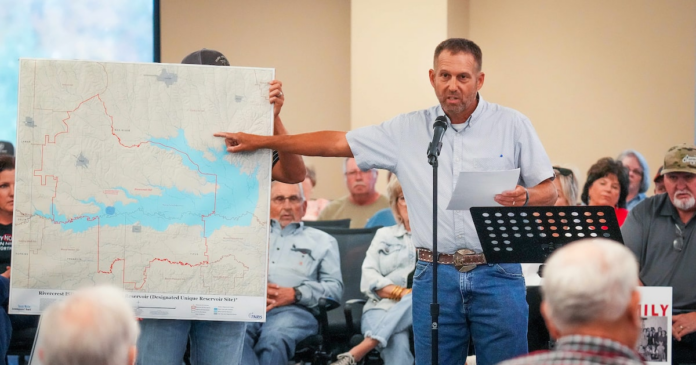There is one reason that the Dallas-Fort Worth region continues to push for the Marvin Nichols Reservoir.
It’s not because there aren’t alternatives. There are — Toledo Bend Reservoir and Lake Texoma, to name a couple.
Advertisement
It’s not because conservation doesn’t work. It does. If the region averaged the same per person water use as many other Texas cities, it would have enough. If you multiply the region’s 2070 population projected in the 2021 Regional Water Plan by the amount of water per person per day other large Texas cities are using, you’ll discover D-FW has enough water now if only the region would conserve like other metropolitan areas.
Advertisement
It’s not because water reuse doesn’t work. Examples abound of cities innovating to meet water needs in Texas and around the world.
Opinion Get smart opinions on the topics North Texans care about. SIGN UP Or with: Google Facebook By signing up you agree to our Terms of Service and Privacy Policy
The reason is simple and it is a motivator as old as time: greed.
The state’s broken water planning process incentivizes it. Private engineering companies assess water needs and make recommendations on how best to meet them. All too often those same engineering companies are the ones who develop the infrastructure they recommend. D-FW’s newest reservoir, Bois d’Arc Lake, is a prime example, where the lead consultant to the Region C Water Planning Group, Freese and Nichols, was also the project manager for the reservoir. What’s worse is the planning process is repeated unnecessarily every five years, so taxpayers have to continually fund studies and assessments that regurgitate the same plans, paying private consultants every step of the way.
Advertisement
Marvin Nichols is the most egregious example of this broken, rubber-stamp process. It was initially proposed in the 1968 Texas Water Plan, along with 66 other projects. The reservoir is named for the man who proposed it, as this newspaper noted in a story recently: “The namesake of the proposed Marvin Nichols Reservoir has ties to well-known water projects throughout Texas and was a partner at the firm consulting on the planned 66,000-acre reservoir.”
As the first chair of the Texas Water Development Board, he went on to influence our statewide water planning process and the “redistribution of East Texas water to the west” for decades, The News reported. Indeed, decades after his death, that redistribution legacy is still evident today.
Reservoirs have been important to the development of Texas water, and water is important to our economic growth and prosperity. No one disputes that. But a destructive, costly solution proposed more than half a century ago simply does not pass the smell test when there are myriad cost-effective alternatives, with conservation and water reuse atop the list.
Advertisement
Water planners recently disclosed the Marvin Nichols Reservoir project has ballooned to a whopping $7 billion price tag that D-FW-area rate payers will have to foot. Alternatives exist, but no one makes money off of conservation.
Advertisement
Texas taxpayers should not have to subsidize a sham water planning process that lines the pockets of engineering firms that recommend billions of dollars’ worth of projects from which they will directly benefit.
One engineering firm is preeminent. Freese and Nichols is a consultant to eight of the state’s 16 water planning regions, as well as the Marvin Nichols project. In the state’s flood planning process, the firm boasts of serving as contractors to 12 of the 15 planning regions. There’s one word for that: monopoly.
We are pleased to see The Dallas Morning News editorial board acknowledge that the region is “wildly wasteful with water.” But conservation is not just an alternative; it’s a responsibility. While cities like El Paso and San Diego are proving that sustainable water management is not only possible but effective, Texas clings to an outdated and exploitative model. The proposed Marvin Nichols reservoir is a relic from another era that would destroy East Texas’ natural heritage for profit.
Advertisement
Every last one of the estimated 200,000 acres to be flooded or taken for mitigation serves to enrich developers and engineering firms. And every family, school or business that would be displaced stands to lose.
It’s time to demand a water plan that values stewardship over speculation and puts people and a sustainable natural environment ahead of profit. Texans deserve solutions rooted in innovation and sustainability. The future of our state’s water lies in conservation — not exploitation.
Justin Lannen is a Dallas resident and chairman of the Texas Conservation Alliance.
We welcome your thoughts in a letter to the editor. See the guidelines and submit your letter here. If you have problems with the form, you can submit via email at letters@dallasnews.com




